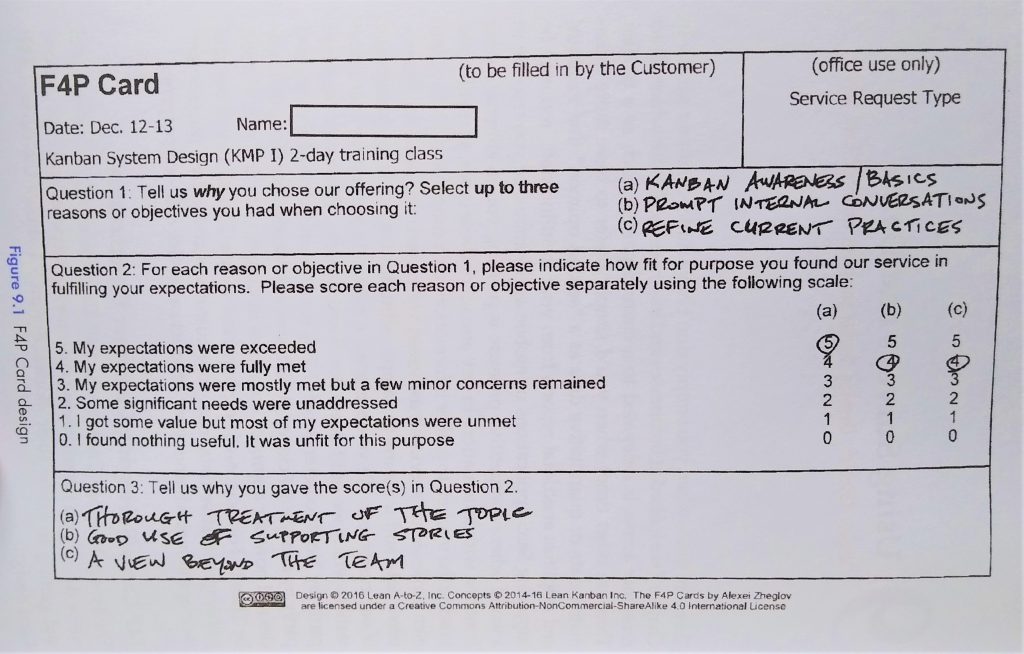Do the results of the surveys are judgmental or irrelevant for your product? Do you feel that surveys are just an annoying duty? Learn more about F4P Card which will change the way how you identify and satisfy your customers true needs.
I remember my anxiety. I have finally collected all of the surveys and started to walk through them.
10/10, wow! I am excellent! 9/10, great!
2/10? Why? What did I do wrong this time? Are there any comments? Yes, “I think there should be more information on the slides”. But wait, what slides? It was a simulation-based workshop. Let’s see another one.
6/10. My first thought: “Not great, not terrible”*. But no comments or justification.
1/10 with comment: “It was amazing training! Can’t wait for more”. Obviously, incorrect side of the scale.
I also had impressions that from time to time participants give higher rates that I do not feel bad about the sessions I conducted.
And so on, and so forth.
Delivering one and the same class every single month, using the same simulations, slide deck, exercise, I could have rating in the range from 1 to 10 with no clue, what was wrong or good. Sometimes comments were irrelevant to the content and I could not do anything about them. Sometimes they were contradictory: delivering the class I read that there was too much information or too less. What can I really do with feedback like this?
I struggled with applying, what people really wanted to tell me, because in most of the cases in was judgmental or irrelevant for the training. I started to focus more on keeping people entertained to make sure I am not too low on Learning & Development department scale. Surveys were just an annoying duty.
Everything changed when I discovered and used F4P (Fit for Purpose) Card for my training. I found the method in the book “Fit for Purpose. How modern businesses find, satisfy and keep customers” by David J Anderson and Alexei Zheglov (this was long before I ever dreamed of becoming an employee at David´s company). Honestly, I did not expect too much. Yet another survey method but worthy of an experiment. However, the results were truly amazing for me as a trainer to improve and to learn what are people’s real expectations and reactions.
Before training started, I asked participants to write down the reasons behind their presence at the class and their expectations. They did not know the content yet, they were not biased by air conditioning, the colour of slides or font density. They set down in the training room with coffee in their hands and were asked: “Tell me, why are you here?”.
After the classes I asked participants to rate (on a scale from 0 to 5), how well the content fits their needs and why they gave this rate.
“0” means they found nothing useful and training was unfit for this particular purpose.
“5” means that their expectations were exceeded.

Why is it so powerful and different from traditional surveying methods? Looking at it from a pragmatic perspective:
- I do not ask about recommending the class to their teammates or colleagues. Even if participants liked the training, it may not be the best choice for other people they know.
- I do not ask them to speculate about their future behaviours, but only about how they experienced the service I provided.
- Trainees can choose out of 6 levels (from “0” to “5”) and each of the levels is explicitly defined, so the chance that someone mistakenly chooses the incorrect level is very low.
- Six levels are psychologically optimal for people to give a meaningful answer. They do not need to spend time to figure out what is the difference for them between 4 and 5 on a scale of 10.
- Question 3: “Tell us why you gave the score in Question 2” gives participants the space to tell their story in relation to original purpose, and what they had in mind entering the classroom. For the trainer it opens up a huge field of learning about satisfaction criteria and the threshold values for these criteria. Additionally, it helps to discover previously unimagined purposes – reasons customers have paid to take the class.
But there is even more – intangible effects F4P Cards bring for the trainer:
- People seem to be more honest, as I do not ask them to rate me as a trainer, but they just say if I provided what they expected to see/hear.
- I received few cards, which had only needs expressed – with no comment or rate. But I saw that I did not fit them at all.
- More than 90% of rates have been commented. And these gave me really powerful feedback.
- A few cards – and this was interesting – told me that needs were 100% different than the training content. But participants rated the session as “exceeding expectations” – because I provided something they did not anticipate.
- Finally, from my private emotions’ perspective, I did not feel bad. Even when I received score “0” or “1” it did not hurt me. It just told me, that I was not able to satisfy this particular trainee requirement. I would learn that also from traditional survey, but the modus operandi behind them does not provide this kind of comfort and safety, which F4P ensures.
F4P Card is only one, tiny element of the “Fit for Purpose” framework described by David J Anderson and Alexei Zheglov. If you are eager to learn more about this concept, which will help you finally understand your customers and keep them satisfied – no matter what you do – try the book “Fit for Purpose. How modern businesses find, satisfy and keep customers” or join “Fit for Purpose” classes.


